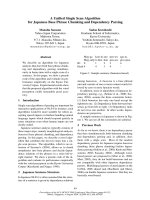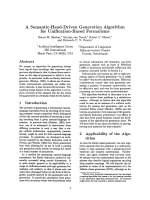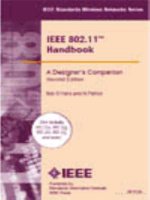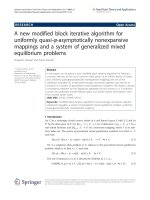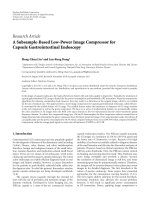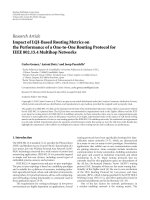Rate prioritized power adaptation a throughput maximizing power conservation algorithm for IEEE 802 11 WLANs
Bạn đang xem bản rút gọn của tài liệu. Xem và tải ngay bản đầy đủ của tài liệu tại đây (346.43 KB, 79 trang )
RATE PRIORITIZED POWER ADAPTATION:
A THROUGHPUT MAXIMIZING
POWER CONSERVATION ALGORITHM
FOR IEEE 802.11 WLANS
RAM PARIKKAL KRISHNAMURTHY
(Matric No: HT070229A)
A THESIS SUBMITTED FOR THE DEGREE OF
MASTER OF ENGINEERING
DEPARTMENT OF ELECTRICAL & COMPUTER
ENGINEERING
NATIONAL UNIVERSITY OF SINGAPORE
2009
Acknowledgements
I would like to dedicate this thesis to my family, especially my parents. I am
extremely grateful for their understanding and support during the period of my
Masters Programme.
I would like to express my heartfelt gratitude to my supervisor, Dr Sadasivan
Puthusserypady K., for his valuable guidance and support in my research work.
He has provided various constructive suggestions and recommendations for my
research work.
I would also like to express my sincere thanks to my colleague, Rajesh Chandrasekhara Panicker, for all his help throughout my research work.
ii
Contents
Acknowledgements
Summary
List of Tables
ii
vii
viii
List of Figures
ix
List of Symbols
xi
List of Abbreviations
xii
1 Introduction
1.1
1
Introduction to Rate/Power Adaptation . . . . . . . . . . . . . . .
2
iii
Contents
1.2
iv
1.1.1
The Time-Varying Wireless Channel . . . . . . . . . . . . .
2
1.1.2
Fundamentals of Rate and Power Adaptation . . . . . . . .
5
Contributions . . . . . . . . . . . . . . . . . . . . . . . . . . . . . .
6
2 Rate and Power Adaptation Techniques: An Overview
8
2.1
Survey of Rate Adaptation Techniques . . . . . . . . . . . . . . . .
8
2.2
Various Power Adaptation Techniques in Literature . . . . . . . . .
18
2.3
Joint Rate and Power Adaptation Techniques . . . . . . . . . . . .
20
3 The RPPA System
24
3.1
Introduction to RPPA . . . . . . . . . . . . . . . . . . . . . . . . .
24
3.2
Principle . . . . . . . . . . . . . . . . . . . . . . . . . . . . . . . . .
25
3.3
RPPA Algorithm Details . . . . . . . . . . . . . . . . . . . . . . . .
26
3.4
Algorithm . . . . . . . . . . . . . . . . . . . . . . . . . . . . . . . .
28
4 Simulations of Unoptimized RPPA System
29
4.1
Determination of the Threshold SNRs . . . . . . . . . . . . . . . . .
30
4.2
Rate Maximization Algorithm . . . . . . . . . . . . . . . . . . . . .
31
4.3
Design Parameters . . . . . . . . . . . . . . . . . . . . . . . . . . .
33
4.4
Simulation and Results . . . . . . . . . . . . . . . . . . . . . . . . .
35
5 Optimization Algorithm for the RPPA System
5.1
Problem Statement . . . . . . . . . . . . . . . . . . . . . . . . . . .
38
38
Contents
v
5.2
Problem Formulation . . . . . . . . . . . . . . . . . . . . . . . . . .
39
5.3
The Probability Density Function (fR (r)) . . . . . . . . . . . . . . .
40
5.4
Power at a Distance r (P (r)) . . . . . . . . . . . . . . . . . . . . .
41
5.5
Average Power (Pavg ) . . . . . . . . . . . . . . . . . . . . . . . . . .
42
5.6
Inner & Outer Radii . . . . . . . . . . . . . . . . . . . . . . . . . .
43
5.7
Optimization . . . . . . . . . . . . . . . . . . . . . . . . . . . . . .
45
5.8
The Optimization Algorithm . . . . . . . . . . . . . . . . . . . . . .
45
6 Optimization and Numerical Simulations of the Optimized RPPA
System
48
6.1
Optimization of the System for IEEE 802.11 . . . . . . . . . . . . .
48
6.2
Simulation and Results . . . . . . . . . . . . . . . . . . . . . . . . .
49
7 Discussions of the Results
7.1
52
Discussion on the Effect of Minimum Power Pmin for the Unoptimized RPPA System . . . . . . . . . . . . . . . . . . . . . . . . . .
7.2
52
Discussion on the Effect of Other Parameters for the Unoptimized
RPPA System . . . . . . . . . . . . . . . . . . . . . . . . . . . . . .
55
7.3
Discussion on Results of Optimization
. . . . . . . . . . . . . . . .
55
7.4
Discussion on Simulations comparing RM and RPPA Algorithms . .
56
7.5
Comparison between Optimized and Unoptimized RPPA Systems .
57
7.6
Discussion on Commercial Deployment of RPPA Algorithm . . . . .
58
Contents
vi
8 Conclusions and Future Work
59
8.1
Conclusions . . . . . . . . . . . . . . . . . . . . . . . . . . . . . . .
59
8.2
Future Work . . . . . . . . . . . . . . . . . . . . . . . . . . . . . . .
60
8.2.1
Practical Rate Adaptation . . . . . . . . . . . . . . . . . . .
60
8.2.2
Design of Practical RPPA Systems . . . . . . . . . . . . . .
62
Bibliography
63
Summary
If the rate and power of WLAN transmissions are kept constant, they have to
be designed for the worst case channel condition, thus resulting in the wastage
of bandwidth and power. Effective utilization of these limited resources is crucial
in wireless communications and hence the rate/power adaptations have become
the focus of many research works. Methods proposed involve techniques for either
power minimization, throughput maximization or a trade off between the conservation of these two resources. In this work, we propose and design a Rate Prioritized
Power Adaptation (RPPA) technique for adapting both rate and power with an
objective of conserving the power while achieving the best possible bandwidth
utilization by maximizing the transmission throughput.
vii
List of Tables
4.1
Label for different Rates of IEEE 802.11
. . . . . . . . . . . . . . . . . . .
31
4.2
Minimum SNR Thresholds for different Rates
. . . . . . . . . . . . . . . .
33
4.3
Minimum Power allowed for different Rates
. . . . . . . . . . . . . . . . .
35
4.4
Label for Minimum Powers in figures
. . . . . . . . . . . . . . . . . . . .
36
viii
List of Figures
1.1
Diagram to depict radio environment and Path loss . . . . . . . . .
1.2
Diagram to depict Path loss, Long Term and Short Term Fading in
3
measured power levels . . . . . . . . . . . . . . . . . . . . . . . . .
4
4.1
BER vs SNR for different rates of IEEE 802.11 . . . . . . . . . . .
32
4.2
Percentage increase in power from RPPA system to RM system vs
No. of power levels (Log base 2) . . . . . . . . . . . . . . . . . . . .
37
5.1
Variation of modes and power levels, on an average, from AP . . . .
42
6.1
Optimum Power Level Values for different number of steps (2,4,8 &
16) . . . . . . . . . . . . . . . . . . . . . . . . . . . . . . . . . . . .
50
ix
List of Figures
6.2
x
Percentage increase in power from an Optimized RPPA system to
RM system vs No. of power levels . . . . . . . . . . . . . . . . . . .
51
List of Symbols
Pmin
Minimum power allowed by the RPPA system
Pmax
Maximum power allowed by the RPPA system
N
Number of power levels in the RPPA system
Pi
Refers to ith power level of the RPPA system
Pavg
Average power used by an RPPA system
P (r)
Average power required by an RPPA mobile at a distance r from AP
fR (r)
Probability density function of nodes with distance from AP
Rmax
The maximum radius till which an AP can communicate with a node
Rmaxi,j
The outer radii of ith power level in j th mode
Rmini,j
The inner radii of ith power level in j th mode
xi
List of Abbreviations
AP
Access Point
BER
Bit Error Rate
DCF
Distributed Coordination Function
MAC
Medium Access Control
QoS
Quality of Service
RM
Rate Maximization
RPPA
Rate Prioritized Power Adaptation
RSSI
Received Signal Strength Indicator
SNR
Signal to Noise Ratio
WLANs
Wireless Local Area Networks
xii
Chapter
1
Introduction
In today’s world, the usage of wireless LANs (WLANs) has become very common
and widespread. Hence the conservation of the resources used by the WLAN devices has gained significant interest among the scientific community. The resources
refer to the bandwidth, which has to be utilized effectively in order to accommodate more users and allow higher bit rates, and the power used by the WLAN
devices, the conservation of which requires focus as many of the WLAN devices
are mobile. The use of these resources in WLANs is optimized by either modifying the physical layer design, which deals with modulation, interleaving, channel
coding, diversity techniques employed etc., or by redesigning the data link layer
using optimized algorithms (Higher OSI layers focus on end-to-end transmissions
and so they are modified only to optimize the network performance; They do not
focus on problems caused by individual channels). This work focusses on improving
1
1.1 Introduction to Rate/Power Adaptation
the data link layer used by WLANs. It involves study and design of a particular
functionality of the data link layer, namely the rate/power adaptation.
This chapter states the contributions of this work and also discusses the fundamentals of rate/power adaptations. The next chapter discusses the different methods proposed in the current literature for implementing the adaptations. Chapter
3 introduces the Rate Prioritized Power Adaptation (RPPA) algorithm proposed
in this work. The simulations performed for an unoptimized RPPA system are
discussed in chapter 4. As the next natural step would be to design an optimized
system to utilize this algorithm, chapter 5 gives details on the optimization of a
general RPPA system. Chapter 6 describes the optimization of RPPA for IEEE
802.11a/g [1], the numerical simulations involved and the results obtained. The
next two chapters discuss the simulation results and draw the conclusions of the
work. The final section points to possible future directions to be followed to improve upon this work.
1.1
1.1.1
Introduction to Rate/Power Adaptation
The Time-Varying Wireless Channel
The radio propagation channel exhibits many different forms of channel impairments, as a result of time varying signal reflections, blockage and motion. These
impairments are broadly classified into three components - Path Loss, Long Term
2
1.1 Introduction to Rate/Power Adaptation
Fading and Short Term Fading. Diagram to depict these are shown in Figs. 1.1 and
1.21 . Figure 1.1 shows, as an example, some points along distances where power
may be measured and marks them as H or L based on whether the power measured
is greater or lower then the path loss component at that point. This is shown to
illustrate the effect of fading and shadowing on received signal. Figure 1.2 follows
to explain how the path loss component is the average power at any distance and
shadowed component is the average of faded power at that distance.
Figure 1.1: Diagram to depict radio environment and Path loss
The path loss is the average decrease in power of signal received as compared to
1
Figures 1.1 and 1.2 are taken from Mobile Communications Engineering: Theory and Appli-
cations by William C.Y. Lee [2].
3
1.1 Introduction to Rate/Power Adaptation
Figure 1.2: Diagram to depict Path loss, Long Term and Short Term Fading in
measured power levels
the power transmitted. It is the component which explains the decrease in the received signal with its distance from the transmitter. The long term and short term
fading components are attributed to the time varying loss observed in received signal measurements. As the name implies, the long term fading component changes
slowly with time and the rapid variation of losses with time is associated to the
short term fading component. Long term fading is also referred to as shadowing
and is caused by the terrain in which the transmissions take place. The short term
fading, on the other hand, takes place due to the receiver capturing not only the
transmitted wave, but also its delayed and weakened copies that are reflected by
the radio environment. Thus the wireless channel causes the received signal power
to be time varying and in turn results in varying signal to noise ratio (SNR) at the
receiver.
4
1.1 Introduction to Rate/Power Adaptation
1.1.2
Fundamentals of Rate and Power Adaptation
This section explains the effect of rate and power adaptation algorithms on the
bandwidth utilization and power conservation. All transmissions are constrained
by a maximum allowed bit error rate (BER) and transmissions resulting in BER
above the limit are declared as unacceptable. For any given BER, the channel
defines the minimum received power required given a transmission rate and also
defines the maximum rate to be used given a received power. This is because
the transmission rate is varied by increasing or decreasing the redundancy in the
transmitted packet and with higher received SNR (i.e. for higher transmitted
power), redundancy required is lesser (thus allowing higher rate) for achieving the
same BER.
As the wireless channel used by the WLAN devices is time-varying, the received
power and so the SNR at the receiver keeps varying with time. Hence, for a given
BER, the rate has to be decreased if SNR reduces and vice-versa. To efficiently
utilize the allocated bandwidth, transmission rate has to be adapted according
to the channel condition (with power constant), rather than designing the system
rate for the worst case condition. The design for worst case channel condition
requires selection of the rate that can be used even in bad channels. So, even when
the channel condition improves, a higher rate cannot be used though the channel
can accommodate it. Thus the worst case design results in poor utilization of the
5
1.2 Contributions
channel and adapting the rate according to the channel condition improves the
utilization. Basically, the rate adaptation scheme is a process of automatically
switching the data transmission rate to match the channel conditions, with the
goal of maximizing the link utilization.
Alternatively, as the channel condition varies, it is also possible to adapt power
accordingly, with the goal of minimizing the power used while keeping the rate
constant. In this case, when channel condition improves, the rate is kept constant
and the power is decreased based on the decrease in the loss observed. Since many
WLAN devices are mobile, power is also an important resource and hence many
research works focus on power adaptation and minimization. There are some algorithms that are focussed in their joint adaptations as well. These algorithms are
concerned with cases where transmission power would have an impact on throughput and trade-off is possible between the conservation of the two resources. Examples of such scenarios are code vision multiple access (CDMA) (where power
affects the interference and hence the throughput) or multi-hop networks (where
an increase in power can save hops).
1.2
Contributions
The contributions of this project are as follows.
6
1.2 Contributions
• This project proposes RPPA algorithm for minimizing power while maximizing throughput in WLAN devices.
• The design parameters for the proposed algorithm are identified and simulations are performed for the different values of the parameters in this project.
These simulations are used to prove the superiority of the proposed method.
• The design parameters are optimized using part analytical and part brute
force approach and thus the optimized RPPA algorithm is designed.
• Simulations are performed for the optimal RPPA system and it is shown
that up to 9% power can be saved while the devices operate at maximum
throughput.
7
Chapter
2
Rate and Power Adaptation Techniques:
An Overview
This chapter discusses the various rate, power and joint adaptation techniques
proposed in literature.
2.1
Survey of Rate Adaptation Techniques
The first documented bit-rate selection algorithm, Auto Rate Fallback (ARF) [3],
was developed for WaveLAN-II 802.11 cards. These cards were one of the earliest
multi-rate 802.11 cards and could send at 1 and 2 megabits. ARF aims to adapt
to changing conditions and take advantage of higher bit-rates when opportunities
appear. It was also designed to work on future WaveLAN cards with more than 2
bit-rates. For a particular link, ARF keeps track of the current bit-rate as well as
8
2.1 Survey of Rate Adaptation Techniques
the number of successive transmissions without any re-transmissions. Most 802.11
wireless cards offer feedback about packet transmission after the transmission has
either been acknowledged or exceeded the number of retries without an acknowledgment. When the ARF algorithm starts for a new destination, it selects the
initial bit-rate to be the highest possible one. Given the number of retries that
a transmission used and whether or not it was successfully acknowledged, ARF
adjusts the bit-rate for the destination based on the following criteria:
1. Move to the next lowest bit-rate if the packet was never acknowledged.
2. Move to the next highest bit-rate if 10 continuous transmissions have occurred
without any retransmissions.
3. Otherwise, continue at the current bit-rate.
As can be seen, this algorithm is very simple and easy to implement.
Adaptive Auto Rate Fallback (AARF) [4] is an extension of ARF where the
step-up parameter is doubled every time the algorithm tries to increase the bitrate and the subsequent packet fails. This can increase throughput dramatically
if packet failures take up a large amount of transmission time. This occurs with
the higher bit-rates of 802.11g and 802.11a since the back-off penalty is so high.
AARF will instead wait exponentially longer before increasing the bit-rate if no
other packet failures occur, which allows it to avoid the throughput reduction
resulting from trying high bit-rates that do not work.
9
2.1 Survey of Rate Adaptation Techniques
But the above algorithms make decisions on individual acknowledgements.
ONOE [5] also uses count of acknowledgements for selection of rate. But rather
than making decision on individual packets, it uses the failure of a batch of packets
to make a decision. Thus it is not prone to individual packet failures, as opposed
to its predecessors.
The algorithm proposed in [6] uses signal strength measurements for selecting
the rate, as opposed to earlier methods. In this paper, they present a link adaptation algorithm which aims to improve the system throughput by adapting the
transmission rate to the current link condition. Their algorithm is simply based on
the received signal strength measured from the received frames, and hence it does
not require any changes in the current IEEE 802.11 WLAN medium access control
(MAC) protocol. Based on the simulation and its comparison with a numerical
analysis, it is shown that the proposed algorithm closely approximates the ideal
case with the perfect knowledge about the channel and receiver conditions.
The thesis [7] presents the SampleRate bit-rate selection algorithm. It uses combination of throughput computation and count of acknowledgement to determine
the rate. SampleRate sends most data packets at the bit-rate it believes will provide the highest throughput. SampleRate periodically sends a data packet at some
other bit-rate in order to update a record of that bit-rate’s loss rate. SampleRate
switches to a different bit-rate if the throughput estimate based on the other bitrate’s recorded loss rate is higher than the current bit-rate’s throughput. Measuring
10
2.1 Survey of Rate Adaptation Techniques
the loss rate of each supported bit-rate would be in-efficient because sending packets at lower bit-rates could waste transmission time, and because successive unicast
losses are time-consuming for bit-rates that do not work. SampleRate addresses
this problem by only sampling at bit-rates whose lossless throughput is better than
the current bit-rate’s throughput. SampleRate also stops probing at a bit-rate if
it experiences several successive losses. This thesis presents measurements from
indoor and outdoor wireless networks that demonstrate that SampleRate performs
as well or better than other bit-rate selection algorithms. SampleRate performs
better than other algorithms on links where all bit-rates suffer from significant loss.
In [8], the authors propose a practical rate adaptation algorithm, Smart Sender,
which utilizes both statistics and the received signal strength indicator (RSSI) of
ACK packets to determine the transmission rate that maximizes the throughput.
They implement the algorithm in commercial WLAN products and carry out extensive experiments for performance evaluation. The results demonstrate that using
throughput computations, count of ACK packets and RSSI of ACKs greatly improves system throughput and responsiveness under various wireless environments.
Zhang et al. focussed on practical constraints in rate adaptation and solved
them [9]. Most work relies only on frame losses to infer channel quality, but
performs poorly if frame losses are mainly caused by interference. In their work,
they conducted a systematic measurement-based study to confirm that in general
SNR is a good prediction tool for channel quality, and identify two key challenges
11
2.1 Survey of Rate Adaptation Techniques
for this to be used in practice:
1. The SNR measures in hardware are often uncalibrated and so the thresholds
are hardware dependent.
2. The direct prediction from SNR to frame delivery ratio is often over optimistic
in interference conditions.
Based on these observations, they present a novel practical SNR- Guided Rate
Adaptation scheme which solves the practical constraints not addressed in other
works.
Another common technique is the one proposed by Qiao et al., where they use
tables of payload length and rate to perform the rate adaptation [10]. In their work,
they present a generic method to analyze the goodput performance of an 802.11a
system under the distributed coordination function (DCF) and express the expected effective goodput as a closed-form function of the data payload length, the
frame retry count, the wireless channel condition, and the selected data transmission rate. Then, based on the theoretical analysis, they propose a novel MPDU
(MAC protocol data unit)-based link adaptation scheme for the 802.11a systems.
It is a simple table-driven approach and the basic idea is to preestablish a
best PHY mode table by applying the dynamic programming technique. The best
PHY mode table is indexed by the system status triplet that consists of the data
payload length, the wireless channel condition, and the frame retry count. At
12
2.1 Survey of Rate Adaptation Techniques
runtime, a wireless station determines the most appropriate PHY mode for the
next transmission attempt by a simple table lookup, using the most up-to-date
system status as the index.
Zhou et al., in [11], use correlation techniques for ascertaining the appropriate
rate. Existing schemes either assume perfect channel information, or conduct rate
adaptation in a black box way, hence can not achieve desirable performance. They
propose a novel scheme called correlation based rate adaptation to address the
rate adjustment problem. Unlike other schemes, this splits rate into more atomic
components and adjusts them according to the correlation between rate adaptation
actions and transmission results. They use IEEE 802.11n as the context for design,
where transmission mode has been expanded to spatial dimension in addition to
the usual modulation and convolution coding mechanisms. Performance evaluation
shows that proposed scheme can conduct rate adaptation in a more logical way
and significantly outperform the comparison scheme.
Won and Kim, in their work, propose a rate adaptation technique which involves
overhearing and determining rates of other users’ packets for evaluating the optimal
rate (as opposed to estimating the channel condition for the adaptation) [12].
Various rate adaptation schemes that select optimal transmission rate according to
the receivers’ channel condition have been proposed. In their paper, they propose a
novel rate adaptation scheme that performs well without control overhead. The key
idea of their proposed scheme is that if a station successfully overhears a downlink
13
